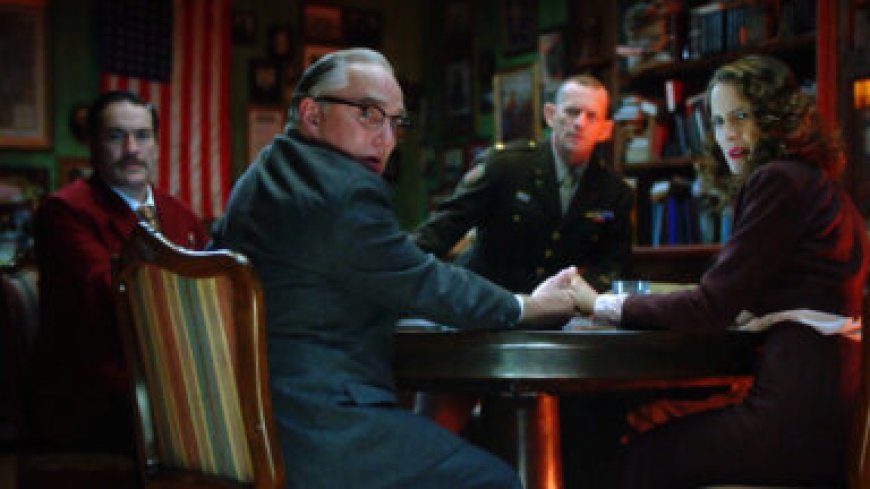‘Brooklyn 45’: a gay veteran stares into the abyss
By this point, you’d be forgiven for groaning at yet another horror film exploring trauma. However, bi director Ted Geoghegan’s “Brooklyn 45” engages with the historical past to an unfashionable degree, while also using it to reflect on the present. (William Wyler’s 1945 classic “The Best Years of Our Lives” hovers over it, but so … Read More

By this point, you’d be forgiven for groaning at yet another horror film exploring trauma. However, bi director Ted Geoghegan’s “Brooklyn 45” engages with the historical past to an unfashionable degree, while also using it to reflect on the present. (William Wyler’s 1945 classic “The Best Years of Our Lives” hovers over it, but so does Off-Off-Broadway theater.) Almost the whole film takes place in one room. Even the introduction of a new character and the persistent presence of a corpse would work if this were staged as theater. Deliberately stripped down, the film doesn’t fit into a cookie-cutter model for the genre.
Just before Christmas in 1945, four friends come together in a Brooklyn brownstone: Marla (Marla (Anne Ramsay), Hock (Larry Fessenden), Archie (Jeremy Holm), and Paul (Ezra Buzzington), joined by Marla’s husband Bob (Ron E. Rains). Despite the surface joviality, violence lingers in the air. Hock’s wife died by suicide just a few months ago. The neighborhood is full of rumors about Nazi spies at work during the war and still living there now. Archie, who is gay, is suspected of a war crime. Marla earned a rare place in the military for a woman in the ‘40s through her skill as a torturer. Still deep in mourning and speaking about his anguished thoughts about death, religion and the afterlife, Hock proposes a séance for the group to carry out to contact his late wife. The séance leads to a shocking act, which apparently traps the group in the house till they’ve found the spy.
“Brooklyn 45” is the cinematic equivalent of a bottle episode. Set in Park Slope, it only shows the street in brief opening and closing scenes. The characters are carefully laid out. Even the production design and lighting contribute to a sensation of being trapped. The green tone of several men’s clothing is reflected in the painted walls.
The narrative of “Brooklyn 45” works like a mystery, based around the attempt to expose a German agent. It goes through the film’s characters, probing their secrets one by one and forcing them to face their darkest thoughts. Without ignoring the homophobia of its period entirely, it avoids stereotypes of tragic closet cases. While he had to hide his gayness within the army, his friends don’t treat it as a deep, dark secret. Archie dresses far more colorfully than the other men, wearing a bright red jacket rather than drab tones. Without imitating any actors from the ‘30s or ‘40s, Holm’s performance carries a dandyish tone that looks back at Cary Grant. Even if his banter with Hock carries a degree of tension about his sexuality, his torment is about his capacity for violence, not his gayness.
Especially in its first half, “Brooklyn 45” can seem rather schematic, where characters’ flaws are brought into the light and examined. Even so, this provides each performer a chance to shine in the spotlight. The film is uncommonly ensemble-oriented. Despite decades of work an actor (as well as a director and producer), Fessenden’s delivery of his anguished monologue hits new heights for him. The supernatural elements are introduced with a light touch. In response to certain lines of dialogue, music suddenly plays. Despite structural films to films like “Clue” or “Knives Out,” the “hell is other people” trap of Jean-Paul Sartre’s play “No Exit” looms much larger than much lighter films.
“Brooklyn 45” looks back at World War II without typical period piece trappings. But it also keeps in mind the late director François Truffaut’s opinion that it’s impossible to make a genuinely anti-war film, keeping the battlefield entirely onscreen rather than representing it directly. Although World War II may have just ended months ago, its effects are just beginning to be felt for these characters. “Brooklyn 45” avoids easy anachronisms, but the ugly attitudes and actions it describes only seem quaint because “kraut” no longer has much sting as a slur. The discussion of Marla’s skill at “interrogation” brings back the euphemistic torture of the Iraq War. It refuses to romanticize the so-called “greatest generation,” but it doesn’t suggest that the present is superior. It’s been much easier for Americans to ignore the aftershocks of the Iraq and Afghanistan wars than we could during World War II, but the true horror in “Brooklyn 45” comes out of the way that even “good wars” end up normalizing violence rather than its supernatural elements. The damage shown here lingers in the background like a quiet ghost.
“Brooklyn 45” | Directed by Ted Geoghegan | Streams on Shudder and AMC+ June 9th

 Mark
Mark 





